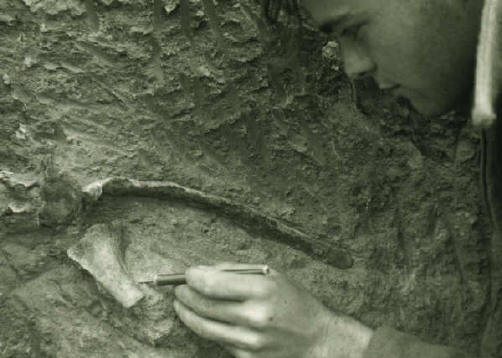|
How Old ? - A Better Answer
Throughout this book the age of the Irvington fossils deposits is given
as approximately 1.3 million years. This is a new estimate established by
scientists at the University of California. The Irvington deposits were
previously thought to be between 500,000 and 800,000 years old. The new
calculation is the result of a new method of dating ancient rocks.
 |
|
Bob Bray in 1950 uncovering fossils
from the T-2 site in Irvington. |
This method, called the potassium-argon (K40/Ar40) method of dating,
enables scientists to determine the age of some rocks so accurately that the
possibility of error amounts to only about 1 percent. It has been in use since
about 1950 and makes possible a more accurate and detailed ordering of past
events both physical and biological.
For scientist attempting to discover the evolutionary development of
living things, this method of dating is extremely important. The method confirms
to a remarkable degree certain earlier estimates of the ages of rocks formed in
the Cenozoic era. These estimates were based on studies of (1) how layers of
rock and fossils within them were deposited, (2) how deeply rocks and fossils
were buried by other sediments, and (3) how various animals developed through
evolutionary change.
The Cenozoic fossil-bearing strata on which K40/Ar40 dates are based have
not been greatly disturbed; that is, they have not been severely broken by
faults or greatly distorted by folding. (Folds are commonly formed by great
pressures that squeeze the strata horizontally.) The strata are in the order of
original deposition. But without knowing (within that small percent of error, at
least) how much older is the stratum underneath than the one above, there is no
way to measure the time it too for evolutionary changes to occur in the animals
that are now buried there.
The ability to closely clock evolutionary changes in living things is of
special importance to the pale ecologist because this also allows him to
estimate the evolution of environments. For example, for several million years
the first horses were browsers, as evidenced by the structure of their teeth.
This means that shrubs and trees were part of their environment. Eventually,
horses became grazers (as are modern horses). Grasses, then, must have become
important features of their environment. If it is possible to closely date the
evolutionary change from browsers to grazers, it thus becomes possible to date
the development of the vegetation upon which these horses lived.
Furthermore, the age of any animal fossil at a particular location
determines the age of all fossils found with it in the same stratum. (Unless, of
course, some came from an earlier cycle of erosion.) By use of the
potassium-argon method, scientists have been able to show that similar types of
animals lived in various locations at the same time. This means that the
environment of these widespread populations were also similar.
|